Microcos tomentosa is a small tree native to tropical Asia that is usually found in mixed or dense forests but also sometimes near villages and cities. Its leaves, which are shiny and reddish when young, are thick, oblong, widening at the top with a toothed margin and a terminal tip; they have 3 characteristic primary veins at the base. The small flowers are grouped in terminal panicles; they have 5 sepals, yellow, white or lilac, and 5 petals, shorter than the sepals, yellow or white; the male flowers carry numerous stamens of irregular length. The fruit is a small drupe with four lobes containing four rounded cores.
In Lao the plant is called khom or khom som, which means “bitter” or “bitter-acid”; in fact, the ripe fruit is edible and is probably a bit acidic and bitter at the same time.
Mak khom is therefore interesting for its edible fruit, which children do not deprive themselves of when they find them, especially since after eating them, they recover the pits, fill a bamboo with them, and then throw them far away by pushing them violently with a stick to produce a machine-gun noise.
Mak khom leaves are said to be a treatment for scabies and its roots are said to treat abdominal disorders.
Mak khom is also sought after for its bark which is made into a decoction that is said to be effective against coughs; in case of fracture, the bark is boiled in coconut milk and then crushed to obtain a paste that is applied to the injured part. From the bark one can obtain fibres which are used to make coarse ropes.
Pharmacological studies have been logically interested in this bark and they have shown that it contains an alkaloid whose one of the properties would be to destroy the larva of the mosquito Aedes aegypti vector of the dengue. Finally, in veterinary medicine, extracts of this plant are given to cats that lack appetite.
Microcos tomentosa est un petit arbre originaire d’Asie tropicale que l’on rencontre ordinairement dans les forêts mixtes ou denses mais aussi parfois près des villages et des villes. Ses feuilles, qui sont brillantes et rougeâtres lorsqu’elles sont jeunes, sont épaisses, oblongues s’élargissant au sommet avec une marge dentée et une pointe terminale; elles ont 3 nervures primaires caractéristiques à la base. Les petites fleurs sont groupées en panicule terminaux; elles ont 5 sépales, jaunes, blancs ou lilas, et 5 pétales, plus courts que les sépales, jaunes ou blancs; les fleurs mâles portent de nombreuses étamines de longueur irrégulière. Le fruit est une petite drupe à quatre lobes contenant quatre noyaux arrondis.
En lao on nomme la plante khom ou khom som, c’est à dire « amer » ou « amer-acide »; en effet le fruit mûr est comestible et il est sans doute un peu acide et un peu amer à la fois.
Mak khom est donc intéressant pour son fruit comestible dont les enfants ne se privent pas lorsqu’ils en trouvent, d’autant qu’après les avoir mangés, ils récupèrent les noyaux, en remplissent un bambou, puis les projettent au loin en les poussant violement avec une baguette pour produire un bruit de mitraillette.
Les feuilles de mak khom seraient un traitement contre la gale et ses racines traiteraient les troubles abdominaux.
Mak khom est recherché aussi pour son écorce dont on fait une décoction qui serait efficace contre la toux; en cas de fracture on fait bouillir cette écorce dans du lait de coco puis on l’écrase pour obtenir une pâte que l’on applique sur la partie blessée. A partir de l’écorce on peut obtenir des fibres qui servent à faire des cordes grossières.
Les études pharmacologiques se sont logiquement intéressées à cette écorce et elles ont montré qu’elle contient un alcaloïde dont l’une des propriétés seraient de détruire la larve du moustique Aedes aegypti vecteur de la dingue. Enfin, en médecine vétérinaire on donne des extraits de cette plante aux chats qui manquent d’appétit.
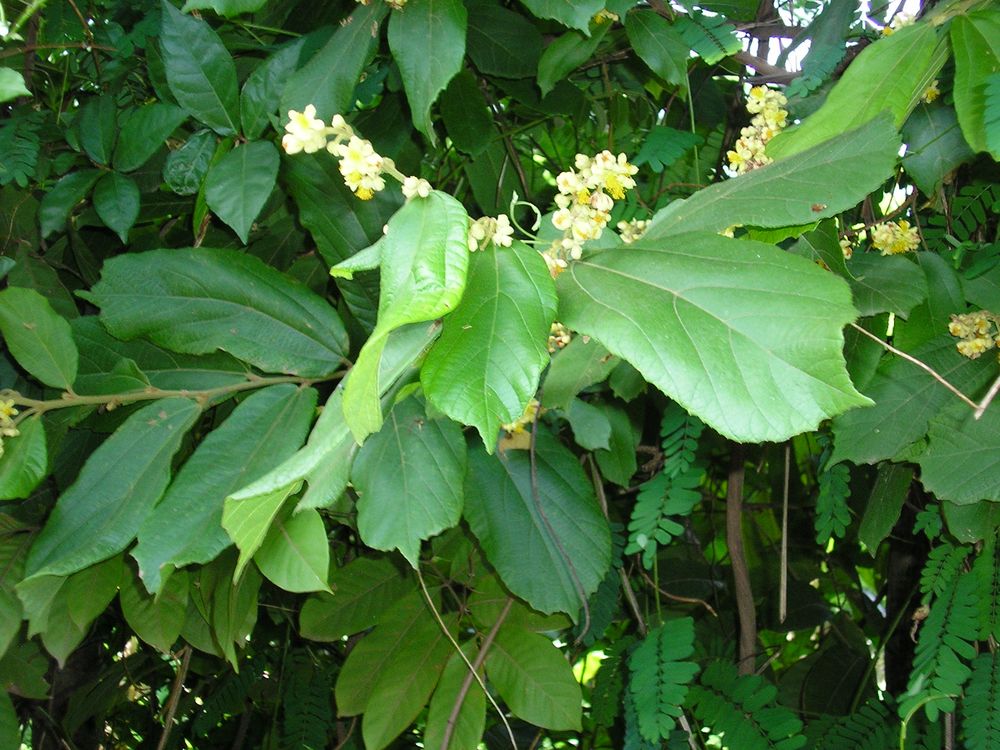
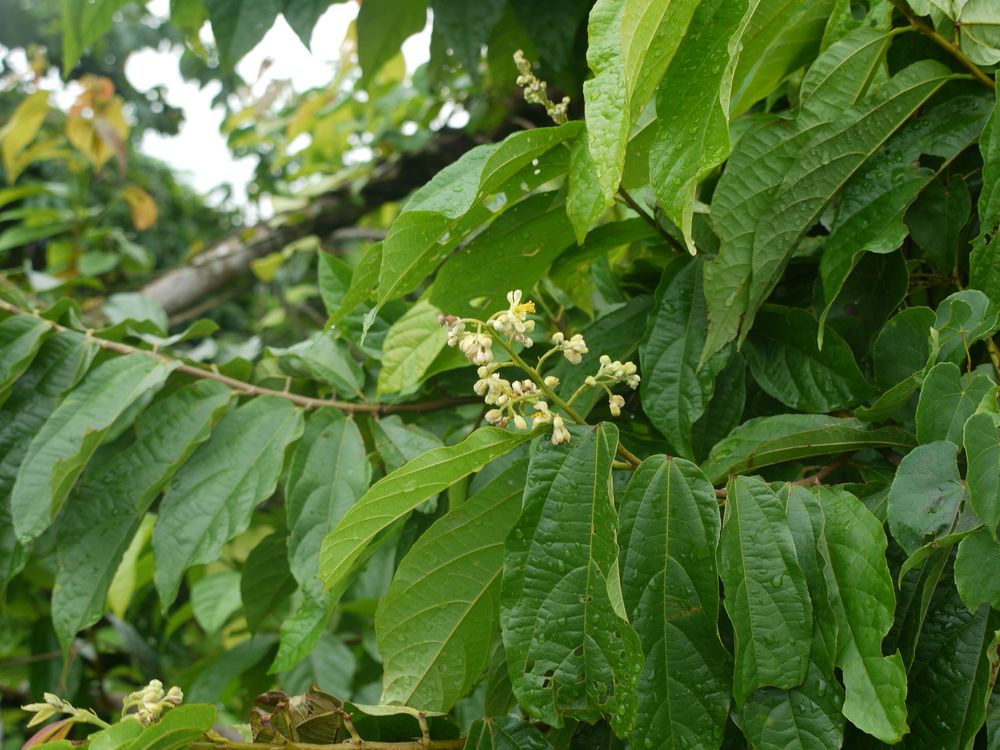
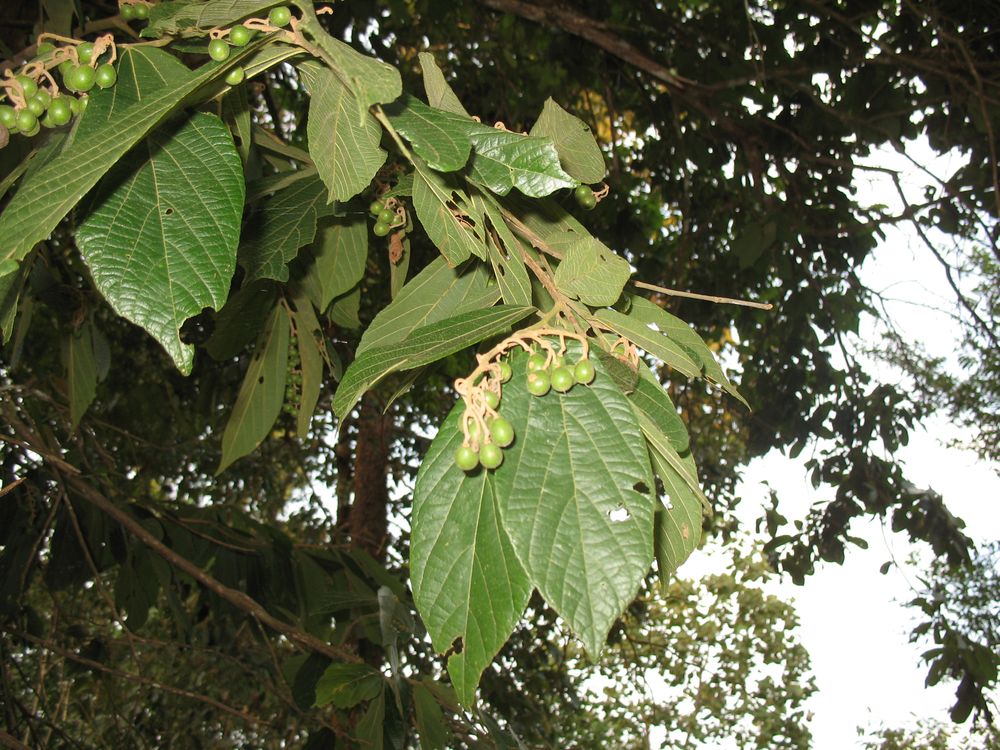
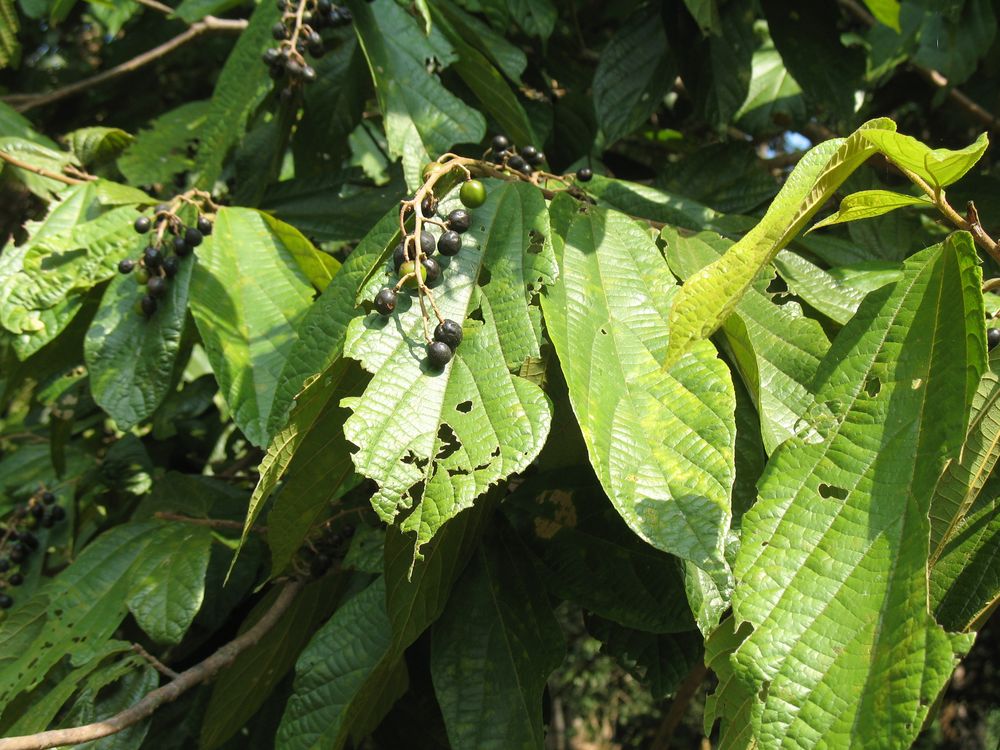
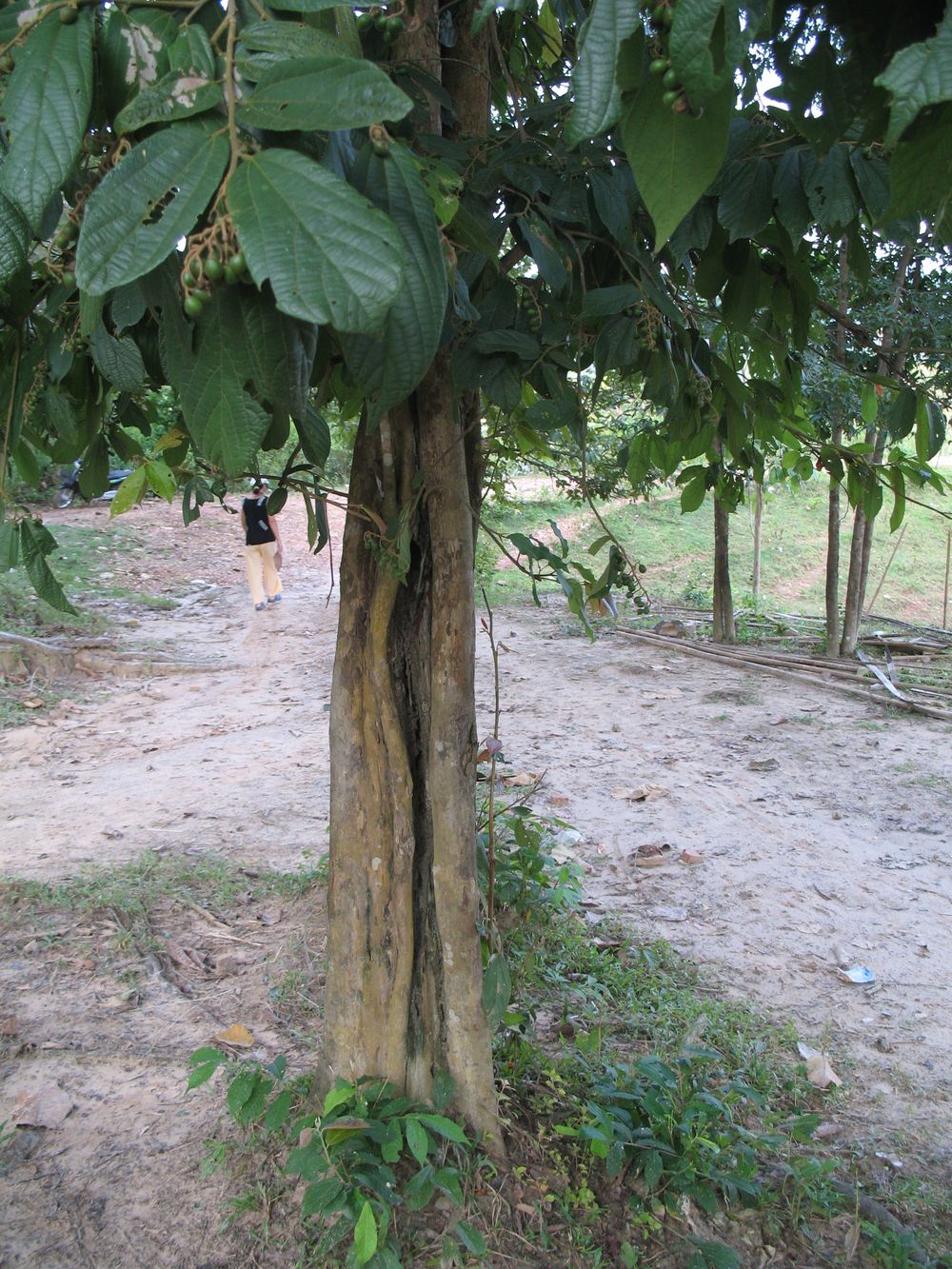
Microcos tomentosa is a small tree native to tropical Asia that is usually found in mixed or dense forests but also sometimes near villages and cities. Its leaves, which are shiny and reddish when young, are thick, oblong, widening at the top with a toothed margin and a terminal tip; they have 3 characteristic primary veins at the base. The small flowers are grouped in terminal panicles; they have 5 sepals, yellow, white or lilac, and 5 petals, shorter than the sepals, yellow or white; the male flowers carry numerous stamens of irregular length. The fruit is a small drupe with four lobes containing four rounded cores.
In Lao the plant is called khom or khom som, which means “bitter” or “bitter-acid”; in fact, the ripe fruit is edible and is probably a bit acidic and bitter at the same time.
Mak khom is therefore interesting for its edible fruit, which children do not deprive themselves of when they find them, especially since after eating them, they recover the pits, fill a bamboo with them, and then throw them far away by pushing them violently with a stick to produce a machine-gun noise.
Mak khom leaves are said to be a treatment for scabies and its roots are said to treat abdominal disorders.
Mak khom is also sought after for its bark which is made into a decoction that is said to be effective against coughs; in case of fracture, the bark is boiled in coconut milk and then crushed to obtain a paste that is applied to the injured part. From the bark one can obtain fibres which are used to make coarse ropes.
Pharmacological studies have been logically interested in this bark and they have shown that it contains an alkaloid whose one of the properties would be to destroy the larva of the mosquito Aedes aegypti vector of the dengue. Finally, in veterinary medicine, extracts of this plant are given to cats that lack appetite.
Microcos tomentosa est un petit arbre originaire d’Asie tropicale que l’on rencontre ordinairement dans les forêts mixtes ou denses mais aussi parfois près des villages et des villes. Ses feuilles, qui sont brillantes et rougeâtres lorsqu’elles sont jeunes, sont épaisses, oblongues s’élargissant au sommet avec une marge dentée et une pointe terminale; elles ont 3 nervures primaires caractéristiques à la base. Les petites fleurs sont groupées en panicule terminaux; elles ont 5 sépales, jaunes, blancs ou lilas, et 5 pétales, plus courts que les sépales, jaunes ou blancs; les fleurs mâles portent de nombreuses étamines de longueur irrégulière. Le fruit est une petite drupe à quatre lobes contenant quatre noyaux arrondis.
En lao on nomme la plante khom ou khom som, c’est à dire « amer » ou « amer-acide »; en effet le fruit mûr est comestible et il est sans doute un peu acide et un peu amer à la fois.
Mak khom est donc intéressant pour son fruit comestible dont les enfants ne se privent pas lorsqu’ils en trouvent, d’autant qu’après les avoir mangés, ils récupèrent les noyaux, en remplissent un bambou, puis les projettent au loin en les poussant violement avec une baguette pour produire un bruit de mitraillette.
Les feuilles de mak khom seraient un traitement contre la gale et ses racines traiteraient les troubles abdominaux.
Mak khom est recherché aussi pour son écorce dont on fait une décoction qui serait efficace contre la toux; en cas de fracture on fait bouillir cette écorce dans du lait de coco puis on l’écrase pour obtenir une pâte que l’on applique sur la partie blessée. A partir de l’écorce on peut obtenir des fibres qui servent à faire des cordes grossières.
Les études pharmacologiques se sont logiquement intéressées à cette écorce et elles ont montré qu’elle contient un alcaloïde dont l’une des propriétés seraient de détruire la larve du moustique Aedes aegypti vecteur de la dingue. Enfin, en médecine vétérinaire on donne des extraits de cette plante aux chats qui manquent d’appétit.










Microcos tomentosa is a small tree native to tropical Asia that is usually found in mixed or dense forests but also sometimes near villages and cities. Its leaves, which are shiny and reddish when young, are thick, oblong, widening at the top with a toothed margin and a terminal tip; they have 3 characteristic primary veins at the base. The small flowers are grouped in terminal panicles; they have 5 sepals, yellow, white or lilac, and 5 petals, shorter than the sepals, yellow or white; the male flowers carry numerous stamens of irregular length. The fruit is a small drupe with four lobes containing four rounded cores.
In Lao the plant is called khom or khom som, which means “bitter” or “bitter-acid”; in fact, the ripe fruit is edible and is probably a bit acidic and bitter at the same time.
Mak khom is therefore interesting for its edible fruit, which children do not deprive themselves of when they find them, especially since after eating them, they recover the pits, fill a bamboo with them, and then throw them far away by pushing them violently with a stick to produce a machine-gun noise.
Mak khom leaves are said to be a treatment for scabies and its roots are said to treat abdominal disorders.
Mak khom is also sought after for its bark which is made into a decoction that is said to be effective against coughs; in case of fracture, the bark is boiled in coconut milk and then crushed to obtain a paste that is applied to the injured part. From the bark one can obtain fibres which are used to make coarse ropes.
Pharmacological studies have been logically interested in this bark and they have shown that it contains an alkaloid whose one of the properties would be to destroy the larva of the mosquito Aedes aegypti vector of the dengue. Finally, in veterinary medicine, extracts of this plant are given to cats that lack appetite.
Microcos tomentosa est un petit arbre originaire d’Asie tropicale que l’on rencontre ordinairement dans les forêts mixtes ou denses mais aussi parfois près des villages et des villes. Ses feuilles, qui sont brillantes et rougeâtres lorsqu’elles sont jeunes, sont épaisses, oblongues s’élargissant au sommet avec une marge dentée et une pointe terminale; elles ont 3 nervures primaires caractéristiques à la base. Les petites fleurs sont groupées en panicule terminaux; elles ont 5 sépales, jaunes, blancs ou lilas, et 5 pétales, plus courts que les sépales, jaunes ou blancs; les fleurs mâles portent de nombreuses étamines de longueur irrégulière. Le fruit est une petite drupe à quatre lobes contenant quatre noyaux arrondis.
En lao on nomme la plante khom ou khom som, c’est à dire « amer » ou « amer-acide »; en effet le fruit mûr est comestible et il est sans doute un peu acide et un peu amer à la fois.
Mak khom est donc intéressant pour son fruit comestible dont les enfants ne se privent pas lorsqu’ils en trouvent, d’autant qu’après les avoir mangés, ils récupèrent les noyaux, en remplissent un bambou, puis les projettent au loin en les poussant violement avec une baguette pour produire un bruit de mitraillette.
Les feuilles de mak khom seraient un traitement contre la gale et ses racines traiteraient les troubles abdominaux.
Mak khom est recherché aussi pour son écorce dont on fait une décoction qui serait efficace contre la toux; en cas de fracture on fait bouillir cette écorce dans du lait de coco puis on l’écrase pour obtenir une pâte que l’on applique sur la partie blessée. A partir de l’écorce on peut obtenir des fibres qui servent à faire des cordes grossières.
Les études pharmacologiques se sont logiquement intéressées à cette écorce et elles ont montré qu’elle contient un alcaloïde dont l’une des propriétés seraient de détruire la larve du moustique Aedes aegypti vecteur de la dingue. Enfin, en médecine vétérinaire on donne des extraits de cette plante aux chats qui manquent d’appétit.


